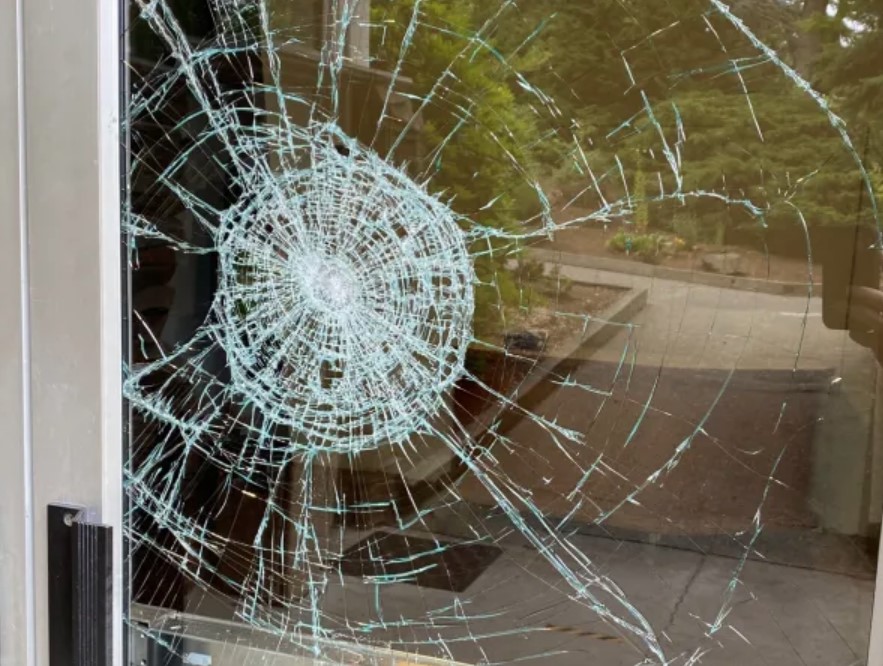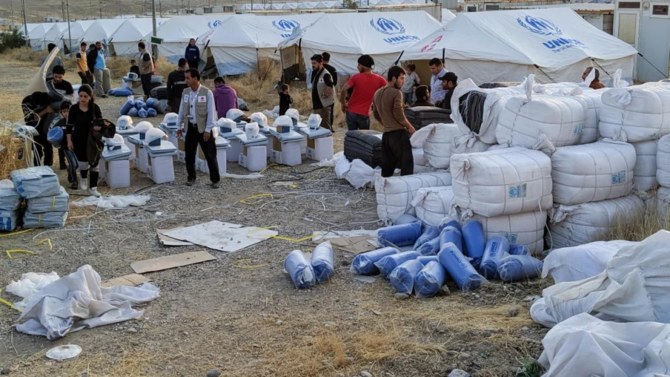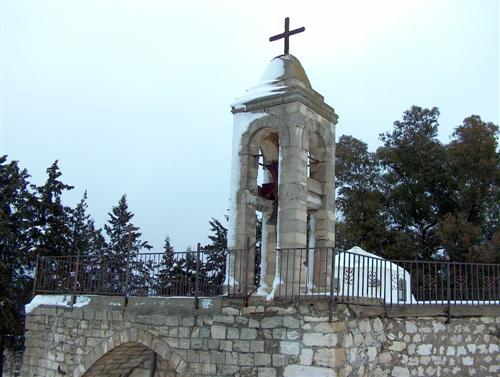
by middleeastmonitor -- Former Israeli Prime Minister Ehud Barak said the Islamic Resistance Movement (Hamas) cannot be eliminated because it is deeply rooted in the hearts and minds of Palestinians, noting that if Prime Minister Benjamin Netanyahu had been in a normal country, he would have resigned after the movement’s sudden attack on 7 October. In an interview with Ynet News yesterday, Barak said: “At the present time he [Netanyahu] is leading the government, so it is very important that in addition to [Defence Minister Yoav] Gallant, that there also be [Former Defence Minister Benny] Gantz and [former IDF Chief of Staff Gadi] Eisenkot, at least to calm the soldiers on the ground.”
Regarding the goals of Israel’s war on Gaza, Barak said: “We cannot completely eliminate Hamas. Hamas is an ideological movement which exists in [Palestinian] people’s dreams, in their hearts and in their minds.” “The practical step the war must achieve is to eliminate all of Hamas’ operational capabilities in the Gaza Strip, and this is a complex enough task, so it should be focused on.” “We intend to eliminate the military capabilities of the Hamas movement, and we also hope that it will be possible to return the Palestinian Authority or any other entity there [Gaza], as there is no place for Hamas in the Gaza government either,” he added. He also referred to the American request to resume water supplies to the Gaza Strip, saying: “I do not think Israel has a choice. America’s standing by us in such a far-reaching way is something that has never happened before, and it also comes at a price. This is one of them.” Hamas: Israel ‘failed ‘miserably’ to make political or military achievement in Gaza
.
الأسرة الخازنيّة واحدة من أكثر الأسر اللبنانية زعامة أهمّيّة وأعرقها، واستمرارًا على عدّة قرون من دون انقطاع. وإن تراجع دورها في بعض المراحل، إلاّ أنّ هذا الدّور لم ينقطع عن أحداث تاريخ جبل لبنان، ولبنان الكيان منذ إعلانه العام 1920 حتى يومنا هذا. يرجع الخوازنة خارج لبنان إلى عرب النّصارى في نواحي الحجاز، وهم من بني غسان. انتقلوا إلى حوران، وسكنوا في قرية أذرع. أمّا في لبنان فقد جاؤوا إلى قب الياس حوالي العام 1450، وانتشروا في جهات نحلة في بلاد بعلبك، ودير الأحمر، واليمونة. ثم انتقلوا إلى جاج حوالي العام 1475. وفي العام 1545 نزحوا من جاج إلى البوار في فتوح كسروان، ومنها إلى بلونة من أرض عجلتون. أدى الخوازنة دورًا سياسيًا مهمًا في عهد الامارتين المعنيّة والشّهابيّة فكانوا مدبرين للأمراء في تلك المرحلة. أمّا في مدّة القائمقاميتين فقد شهدت المرحلة صراعات دموية تراجع معها دورهم خصوصًا بعد ثورة الفلاحين العام 1858. أمّا في عهد المتصرفيّة فقد عادوا إلى السّلطة من خلال تسلّم الوظائف في الإدارة.
كلمات المفاتيح: المدبر، دهقان، المقاطعجي، المديرية، الناحية، الأموال الأميرية، الأجباب….
Abstract
Al-Khazen family is one of the most important and oldest Lebanese leadership families. Its leadership has continued for centuries without interruption. Although its role declined during some periods, it has not been interrupted by the events of the history of Mount Lebanon, and later Lebanon since its declaration in 1920 until the present day. The origins of the Khazens return to the Christian Arabs in the regions of the Hijaz; they are from Banu Ghassan. They moved to Houran, and lived in the village of Adre‘. They came to Qab Elias in Lebanon around the year 1450, and deployed in the regions of Nahla in Baalbek, Deir al-Ahmar, and Yammouneh. Then they moved to Jaj around 1475.
In the year 1545, they were displaced from Jaj to al-Bouwar in Foutouh Keserwan, and from there to Ballouneh in Ajaltoun. The Khazens played an important political role during the reign of Ma‘an and Chehab emirates; they were the administrators of the emirs. As for the period of the two Qaimaqamites, bloody conflicts occurred during which their role declined, especially after the Peasants’ Revolution in 1858. As for the era of the Mutasarrifiyya, they returned to power by taking over posts in the administration.
Keywords: al-Mudabbir, Dehqan, al-Muqati‘ji, department, region, domanial money, branches
Palestine’s growing tech industry has been literally blown apart by the war between Israel and Hamas

By Mike Butcher -- techcrunch.com -- Gaza, despite being one of the most economically challenged regions in the world, has ironically always been a tech hub — not only for Palestine and Palestinians, but for the world: International companies have, for many years, sought out a presence there to collaborate both with talented tech freelancers, and the startups which gradually emerged from the region. For examples, according to sources who helped build those bridges, Nvidia, famed for its role in the new AI boom, has been working with at least 100 engineers from the region for years. Since at least 2008 TechCrunch been covering technology companies out of Palestine, some serving their direct audience, some serving the tech world internationally. Silicon Valley had taken an increasing interest in Palestine as a tech hub, but like the ecosystem itself, it’s nascent: To date, those working in the region estimate that as much as $10 million has been invested in the Palestinian tech ecosystem. Notably, in 2017, Salesforce founder and CEO Marc Benioff joined Silicon Valley luminaries in backing the first-ever coding academy to be created in Gaza. Gaza Sky Geeks, an Alphabet-backed initiative based in Gaza that provides pre-seed investments, training and technology resources to Palestine’s Gazan population, has been a beacon of entrepreneurship in the region. All of that is now, effectively, gone, like the buildings in Gaza itself.
Israel is currently retaliating militarily against the attacks on its people, on its soil, and the hostages subsequently taken by Hamas — the ruling organisation in Gaza that kidnapped at least 150 people and took them into Gaza during brutal attacks on Israel last weekend that killed 1,300 people. That strategy has seen it pummeling the ‘Gaza Strip’ with bombs to eradicate it of Hamas and to get its hostages back. Over 1,500 people in Palestine so far have been killed as a result. The tech industry in Israel — the country’s biggest export, and its biggest single contributor to GDP — is also taking a big knock (read about that here), but the impact on the smaller and more fragile ecosystem in Gaza has been, inevitably, significantly more serious. The physical, economic and societal destruction resulting from that leaves any future for the tech industry there in doubt.

by techcrunch.com -- Ingrid Lunden, Ron Miller -- The world is still coming to terms with Hamas’ deadly attacks on Israelis last weekend — and everything else that has unfolded so far in the aftermath, including the barrage of retaliation strikes on Gaza. A look at how the situation is playing out in the startup ecosystem sheds light on its impact to the country as a whole. In such a small country, just about everyone knows someone who was directly affected by the attacks, or someone involved in the subsequent defense and retaliation — and often all three. Technology is, without question, a giant part of Israel’s economy. In 2022, it contributed more than 18% of the country’s GDP, the most of any single sector, according to the latest annual report from the Israel Innovation Authority.
A total of 14% of Israeli citizens work in high tech, which in a country of just 9.2 million people works out to about 1.3 million. The active number of startups in the country is 9,000 (third-highest in the world after the Bay Area and NYC) and these startups have collectively, in the last five years, brought $95 billion into the country by way of venture capital. Combining the business development of startups with larger tech companies in the country — Intel, Microsoft, Nvidia, Google and many others have operations in Israel — they collectively exported $71 billion last year, 48.3% of the total amount exported across all industries. Undoubtedly, those numbers are all going to be significantly lower this year, not least because the disruptions of this war are coming directly on the heels of a major protest movement.
Khazen History


Historical Feature:
Churches and Monasteries of the Khazen family

St. Anthony of Padua Church in Ballouneh
Mar Abda Church in Bakaatit Kanaan
Saint Michael Church in Bkaatouta
Saint Therese Church in Qolayaat
Saint Simeon Stylites (مار سمعان العامودي) Church In Ajaltoun
Virgin Mary Church (سيدة المعونات) in Sheilé
Assumption of Mary Church in Ballouneh
1 - The sword of the Maronite Prince
2 - LES KHAZEN CONSULS DE FRANCE
3 - LES MARONITES & LES KHAZEN
4 - LES MAAN & LES KHAZEN
5 - ORIGINE DE LA FAMILLE
Population Movements to Keserwan - The Khazens and The Maans
ما جاء عن الثورة في المقاطعة الكسروانية
ثورة أهالي كسروان على المشايخ الخوازنة وأسبابها
Origins of the "Prince of Maronite" Title
Growing diversity: the Khazin sheiks and the clergy in the first decades of the 18th century
Historical Members:
Barbar Beik El Khazen [English]
Patriach Toubia Kaiss El Khazen(Biography & Life Part1 Part2) (Arabic)
Patriach Youssef Dargham El Khazen (Cont'd)
Cheikh Bishara Jafal El Khazen
Patriarch Youssef Raji El Khazen
The Martyrs Cheikh Philippe & Cheikh Farid El Khazen
Cheikh Nawfal El Khazen (Consul De France)
Cheikh Hossun El Khazen (Consul De France)
Cheikh Abou-Nawfal El Khazen (Consul De France)
Cheikh Francis Abee Nader & his son Yousef
Cheikh Abou-Kanso El Khazen (Consul De France)
Cheikh Abou Nader El Khazen
Cheikh Chafic El Khazen
Cheikh Keserwan El Khazen
Cheikh Serhal El Khazen [English]
Cheikh Rafiq El Khazen [English]
Cheikh Hanna El Khazen
Cheikha Arzi El Khazen
Marie El Khazen